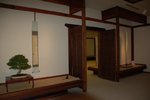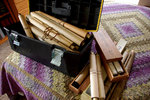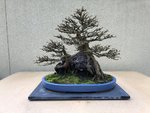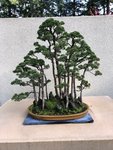NEAR VIEW & DISTANT VIEW FORESTS
Like any style of bonsai, the beauty of the total aesthetic impact is most important. The emotional beauty the viewer feels differs from individual to individual. Generally, when viewing a bonsai a viewer does not think “That’s a good cascade style I can see it struggling to grow out of cliff” or “That forest looks like a near view form because I can see myself standing in front of the trees”. Beauty of the composition is paramount, not necessarily the label of the style.
Classifying bonsai is not important when appreciating bonsai. Some people like a composition and others may not. Although personal evaluation of a bonsai depends on the individual it is important to consider the source. Some people are not familiar with bonsai or are just beginning do not have the experience to back up their thoughts and rash statements. There are many different levels of bonsai appreciation. Beginners may see beauty (especially when voting for a “people’s choice award”) while an experienced professional trained bonsai artist may see something vastly different depending on their background and form of bonsai they practice.
However, as a bonsai educator with over 50 years of experience I have learned that there are some guidelines necessary to teach and to assist students how to create and design their own bonsai. Just arranging trees in a container haphazardly does not mean the composition is good or acceptable to people familiar with bonsai. They may like the forest as is and appreciate it, which is fine and good. As long as they like their work, its good. However, if one wants to improve their design, some guidelines are required. That’s where the bonsai educator comes in handy.
Classifying a bonsai forest as a near view or distant view is an important teaching aid when trying to help others enjoy the art.
Yes, I’m quite familiar with Saburo Kato’s book
Forest, Rock Planting & Ezo Spruce Bonsai. I was the one who compiled and edited the text. I’ve known the Kato family for 50 years now, Saburo Kato, his brothers, his sons and grandson. I doubt if Mr. Kato ever sat down and said I’m going to design a distant view forest. Like many artists Mr. Kato created from his heart, depending on the material used. He was quite skilled in both distant and near view forests, usually using evergreens. On the other hand, Fusazo Taeyama and his son Hiroshi, specialized in deciduous, unusual and forest bonsai. But they tended to create distant view deciduous forests. The two Trident Maple forests illustrated in Post 40 were created by Mr. Takeyama.
As stated, generally near view forests have fewer trees with large heavy trunks with often the main heavy tree in the foreground. Distant view forests generally have more trees in the composition, with thinner trunks and the main tree in the center of the composition. Near view forests are primarily appreciated for their trunks and branches. Distant view forests are usually appreciated for their silhouettes and twigs, not necessarily individual trunk shapes.
Below are two forests. The first near view style was created by Saburo Kato using Ezo spruce he collected. The second distant view forest was created by me using Chinese elm seedlings and is appreciated for the fine twigs.
No matter what you name a bonsai, please remember the most important aspect is the true beauty of the composition and how it moves you.
Bill















